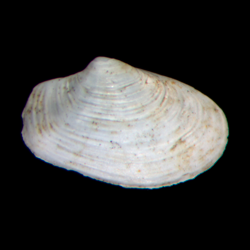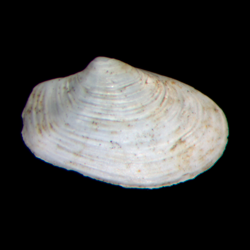
Thraciidae

- Phylum: Mollusca
- Class: Bivalvia
- Order: Anomalodesmata
- Family: Thraciidae
Overview
Common name: Thracia clams or lantern shells
Key morphological features: The Thraciidae are small to medium sized, up to 90 mm. The shells are equivalve or inequivalve, with the right valve larger and overlapping the left. They are thin-walled, and rounded or distorted in shape. The posterior end is either truncated or bluntly rostrate, and the posterior end gapes in some species. The shell is composed of aragonite and exterior sculpture is smooth to granulate, with occasional striations, commarginal ridges, or undulations. Valve interiors of modern species are non-nacreous, although Mesozoic species did have nacreous interiors. The pallial line has a shallow or deep sinus, and the interior shell margins are smooth. Species of Thraciidae are heteromyarian, and the anterior adductor muscle is narrower than the posterior. The edentate hinge is either internal or external, with a calcareous ossicle. Source: Mikkelsen, P.M., and Bieler, R. 2008. Seashells of Southern Florida: Bivalves. Princeton, New Jersey: Princeton University Press. 503 pp.
Geological range: Jurassic to Recent (Mikkelsen & Bieler, 2008).
Geographic distribution: A distributional map for modern Thraciidae may be accessed from OBIS. A distributional map for ancient Thraciidae may be accessed from the Paleobiology Database.
Diversity: There are 92 recognized living species of Thraciidae and 17 genera (WoRMS database, unvetted). The Paleobiology Database recognizes 5 fossil genera and 40 fossil species of Thraciidae (unvetted).
Paleoecology: The Thraciidae are marine suspension or deposit feeders. They usually live infaunally, buried in fine or coarse mud or sand, although some species will nestle in rock crevices. Thraciids are slow burrowers, but are able to rebury themselves if exposed. They have hardened siphonal tips that allow them to keep their siphons away from predators, below the sediment surface. They are found worldwide in subtidal to moderately deep waters, and can withstand a range of temperatures from temperate to cool. Source: Mikkelsen and Bieler (2008).
Phylogenetic status: Unknown.
